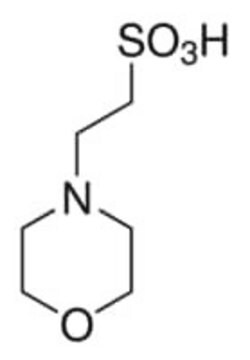M5057
MES sodium salt
BioReagent, ≥99% (titration), crystalline
Sinónimos:
Ácido 2-(N-morfolino)etanosulfónico sodium salt, Ácido 4-morfolinoetanosulfónico sodium salt
About This Item
Productos recomendados
product line
BioReagent
Quality Level
assay
≥99% (titration)
form
crystalline
pH
8.9-10.1 (1% in water)
useful pH range
5.5-6.7
pKa
6.1
solubility
water: 0.5 g/mL, clear, colorless
application(s)
diagnostic assay manufacturing
storage temp.
room temp
SMILES string
[Na+].[O-]S(=O)(=O)CCN1CCOCC1
InChI
1S/C6H13NO4S.Na/c8-12(9,10)6-3-7-1-4-11-5-2-7;/h1-6H2,(H,8,9,10);/q;+1/p-1
InChI key
IRHWMYKYLWNHTL-UHFFFAOYSA-M
¿Está buscando productos similares? Visita Guía de comparación de productos
Categorías relacionadas
General description
Application
- To achieve the required density and stretching of DNA fibers during melting of agarose plugs containing genomic DNA
- To equilibrate the Balch homogenizer chamber and to prevent sample hydrolysis before sample homogenization
Preparation Note
Other Notes
¿No encuentra el producto adecuado?
Pruebe nuestro Herramienta de selección de productos.
Storage Class
13 - Non Combustible Solids
wgk_germany
WGK 1
flash_point_f
Not applicable
flash_point_c
Not applicable
ppe
Eyeshields, Gloves, type N95 (US)
Certificados de análisis (COA)
Busque Certificados de análisis (COA) introduciendo el número de lote del producto. Los números de lote se encuentran en la etiqueta del producto después de las palabras «Lot» o «Batch»
¿Ya tiene este producto?
Encuentre la documentación para los productos que ha comprado recientemente en la Biblioteca de documentos.
Los clientes también vieron
Nuestro equipo de científicos tiene experiencia en todas las áreas de investigación: Ciencias de la vida, Ciencia de los materiales, Síntesis química, Cromatografía, Analítica y muchas otras.
Póngase en contacto con el Servicio técnico







